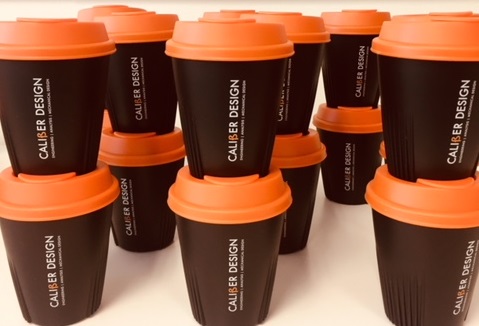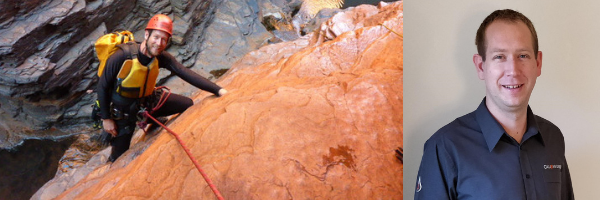Watch out New Zealand, Caliber Design has reached adolescence! Demand for our project-based engineering services has grown steadily and rapidly since we started out in 2015. We’re excited to be now putting in Regional Managers for the South Island and Waikato and employing an HR Specialist to support our staff and recruitment practices. These new roles mean that we can provide even better service to our clients and ensure our team are being well looked after. A win:win for everyone.
5 WAYS KIWI INGENUITY IS MAKING INDUSTRY SMARTER
Consumer demand for performance, quality and sustainability is often at odds with the growing constraints of climate change, over population, and limited resources. As kiwi innovators, we need to continually focus on smart use of resources. This article profiles some kiwi companies that are leading the way.
CONJURING DESIGNS FROM THIN AIR IN A VIRTUAL WORLD
Following decades of development, business applications for vitual reality are now within our grasp. This article talks about how designers can ‘see’ new cars, factories, and houses before they’ve been built. Graphics quality is getting better, processing speeds faster, headsets more comfortable. The future is now!
DAY IN THE LIFE OF A DRONE ENGINEER VIA ENGINEERING NZ
Engineering New Zealand have released a video series “Engineered for Life”. This video is about Seamus Rowe, co-founder and engineer at Dotterel Technologies—experts in noise reduction and audio enablement in unmanned aerial vehicles and drones. More revoluntionary tech from New Zealand!

Welcome Geoff Blokland
We’re thrilled to welcome Geoff Blokland into the Caliber family this month. Geoff has taken on the role of Regional Manager for the South Island.
Geoff’s career has revolved around manufacturing engineering. He got his trade qualifications and NZCE Production, Manufacturing Engineering and “served his time” at CWF Hamilton & Co. He taught CAD, the trades, and NZCE, at Christchurch Polytechnic. Since then, he’s worked in a range of engineering management positions across a range of industries—CAD reseller, plastics, mining (global), compressed air, roading and construction, and engineering consulting.
Some of Geoff’s key achievements include:
- Manufacture of 12 works race jet units for 1986 world jet boat marathon—the emergence of the bullet type high efficiency impeller hub
- Youngest foreman in company history at CWF Hamilton & Co (even married one of the bosses daughters!)
- International Skill expert (CAD) for Skills Olympics
- Design and delivery of CPIT’s foundation ‘3D drawing and Modeling’ technical drawing courses (1989)
- Removing his LH small finger on end of handlebars
- Modelling and creation of manufacturing drawings for road bitumen sprayer for Fulton Hogan
Read a bit more about Geoff here.
CONTACT | Geoff Blokland, SI Regional Manager | 021 206 3413

Turning Plastic Waste into Fence Posts
Once again, our director Jonathan Prince was honoured to be a judge in the Innovation Tent at Fieldays in June.
Just like every other year, JP was impressed by the talent and innovation that was on show.
This year’s winner was South Auckland fencer and farmer Jerome Wenzlick from Future Post. They are making fence posts out of plastic that would otherwise be sent to landfill. They expect to turn 1,000 tonnes of soft plastics into fence posts this year.
The posts are designed, re-purposed, and made in New Zealand. The product is approved for use on organic farms.
The fact that the posts can’t be chewed, don’t absorb water, and don’t need to be treated with chemicals means that farmers aren’t put off by the fact that the posts are slightly heavier and more expensive that their timber counterparts.
MORE INFO | Future Post website | RNZ Interview | Stuff Article | Fieldays Award Recipients

Keeping In Touch
As with our newsletter, we use social media to celebrate what’s happening in the mechanical design space within NZ. We’re all about sharing good news and innovative ideas, adding value, and always learning.
Follow us on Facebook or LinkedIn this month, comment on one of our posts, and go in the draw to win a Caliber reusable cup—made in NZ by the wonderful people at Ideal Cup.

Changes in Waikato Office
Innovators are flocking to the Waikato—some say it has potential to be the next Silicon Valley. “We have got some good stuff going on in the Waikato, it’s one of our best kept secrets, which is wrong. We need to be sharing this.” Michael Bassett-Foss, CEO @ Te Waka.
It’s this potential that has lead Caliber Design to strengthen our committment to the region, by promoting senior engineer Marcel Kamp to the role of Waikato Regional Manager.
Here are some words from Marcel about his new role:
My two years with Caliber Design as a senior engineer has given me a good grounding in Caliber’s core values and way of working. Now that I am moving into the role of regional manager I am looking to grow Caliber’s unique offering to clients in the Waikato and Bay of Plenty.
My background spans a large range of industries including machine design, aerospace, automation, automotive, rail, mining, factory layouts and process design. This allows me to understand the unique requirements of different industries and allocate the appropriate resources to give the best value to the project. My strengths lie in listening to the customer’s needs, understanding the requirements, and putting solutions in place.
My plan for the Waikato/BOP region is to work with businesses to find synergies between what they do and what we can offer, while growing the number of skilled engineers we have available locally. This will allow us to provide a reliable as-required service out of Hamilton.
My passions in life, apart from engineering, are my family, and to get out and see the world. Fortunately I am able to combine both of these on many occasions. Any excuse to explore a new place, travel to a different country, or just to get to know the local area. I see myself a very practical and hands on person, unafraid to learn new skills and give things a go.
I look forward to talking to all of our current and prospective customers about their businesses, the types of projects they undertake and discussing what value Caliber can add to their upcoming work pipeline.
CONTACT | Marcel Kamp, Waikato Regional Manager | 021 0850 4275
NZ Aerospace Challenge
“The Challenge will recognise one of the biggest issues facing the agricultural sector—sustainability. Applicants will be asked to develop a product or service that detects, monitors or measures water or soil pollution using the very latest satellite and unmanned aircraft (UA) technology.”
Caliber Design is a proud partner of this event, with Jonathan Prince taking on a role as mentor, along with an inspiring bunch of business and innovation leaders.
The participants have been selected from applicants around the country. We’re excited to be part of this and will keep you posted on progress.
MORE INFO | nzaerospacechallenge.com

Learning is a Must: Communication Skills
Technical skill and prowess goes a long way in engineering, but if you can’t get your point across then it will only get you so far. So say the communication gurus, and on balance I’d agree with them.
Our engineers are embarking on a ‘refresher’ round of communication training, based on the successful results we saw from an earlier round (when our team was rather a lot smaller than it is now!).
We chose to run the refresher because the positive effects of being able to clearly articulate a point or concept to other engineers, resolve a difference of opinion, or communicate technical ideas to a non-technical audience make a significant difference to the success of a project.
The power of communication was evident in two recent events we’ve attended, hosted by Engineering New Zealand:
- The Great Energy Debate: the speakers produced varying levels of technical content but the more compelling argument was delivered by those speakers who engaged with the audience and were able to modify the delivery of their content to suit.
- Caliber Tech Talk: Caliber presented a range of recent projects around the theme of successes and lessons learned. While it’s true that our technical skill was a factor in the more successful projects, I got the impression that the audience was just as impressed with our abilities to get multiple stakeholders with conflicting requirements on board and in agreement, and our approaches to managing expectations in order to maintain good relationships. Conversely, our more challenging projects presented not just technical learning opportunities but also identified where our communication could have been better. We learn from our mistakes though, and share those lessons with our team in our pursuit of continual growth and improvement.
One of our company values is “learning is a must”. It is a constant focus. So if you see some fresh faces next time you engage Caliber on a project, be assured that they’ve had the full benefit of our training—in both technical and those more subjective ‘human’ skills.
ARTICLE BY | Simon Hall, Design Manager

“As a manager I’m sceptical about the accuracy of FEA software and I’d rarely use it for making decisions—I’d much rather just see some hand calcs.”
We hear statements like this quite frequently … it’s not an uncommonly held opinion in engineering businesses here in New Zealand. However, there are more and more examples of FEA being used successfully to save companies large amounts in development costs in the news—so where does this scepticism come from?
Pretty much any common professional FEA software (i.e. SolidWorks Simulation, ANSYS, etc) will give you an accurate solution to the problem you ask it to solve*—much like a desktop calculator. So rather than thinking: Is my calculator accurate?, some better questions to ask are:
- Am I entering the correct numbers?
- Am I entering the numbers correctly?
- Am I comfortable I can interpret the results effectively?
FEA software is everywhere these days and a lot easier to use than it once was, however as with calculators, bad inputs will always give bad results—FEA software isn’t smart enough to know whether the problem you’re trying to solve has been correctly defined (well, yet at least!). As you can imagine then, the focus should be less on the software and more on the skills of the operator and the process they follow to avoid mistakes.
Checkout this blog post to learn about the Six Steps to Accurate FEA that our Caliber analysts follow to ensure the results we present to our clients as accurate as possible.
If you’d like to chat about your current FEA process and how it could be updated, feel free to drop me an email—I’m always happy to help!
*as long as you’re not pushing the software to its absolute limits where the odd ‘bug’ may arise
ARTICLE BY | Ashley Brittenden, Analysis Manager
Shortage of resources? Looming deadline? Skill gap that needs to be filled?
We have talented engineers with experience and innovative ideas, ready to help. Just drop us a line!
Wayne Le Sueur
021 140 4944
wayne.lesueur@caliberdesign.co.nz
Andrew Jackson
021 774 286
andrew.jackson@caliberdesign.co.nz



